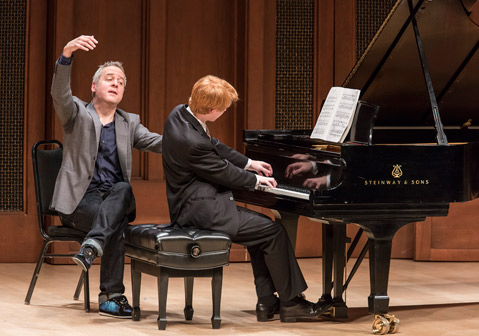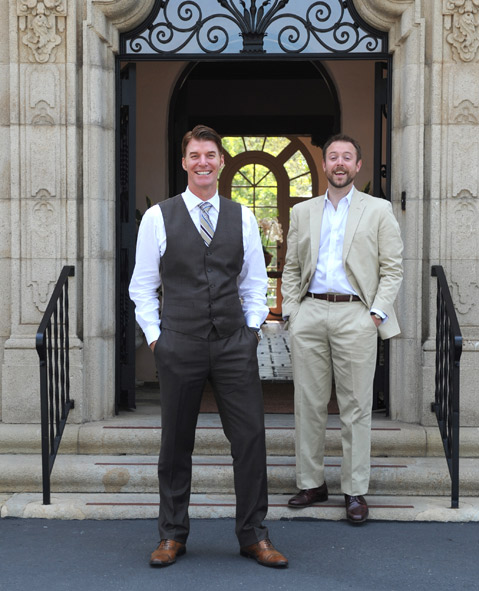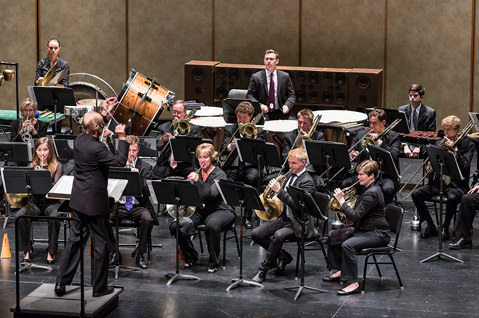The Music Academy of the West Goes Big
New York Philharmonic Partnership and More

At 3:30 in the afternoon on the Fourth of July — a time when many patriotic Americans have their hands wrapped around a cold beverage — 21 Music Academy of the West string fellows sit in Weinman Hall, their hands clasping the instruments that brought them here: 21 beautiful, precious violins. They have assembled for String Leadership Masterclass with Jorja Fleezanis, a violinist who is one of the world’s most distinguished concertmasters and a full professor at the Jacobs School of Music at Indiana University. And despite the beautiful weather on this holiday Friday in Montecito, they are not alone, because directly across from them there sits an audience of some 30 people whose idea of fun on the Fourth of July involves bearing witness to great teaching.
Fleezanis and her students do not disappoint. After leading the mostly soft-spoken young musicians through an opening discussion about the general principles behind leading a section of the orchestra, Fleezanis gets her first big-idea answer of the morning. It comes from Mia Laity, a 21-year-old student from the Manhattan School of Music who describes conducting as “putting into visual form the gestures that you hear in the music.” Fleezanis’s face lights up in agreement, and she responds to the remark by explaining that the conductor serves as “a kind of weathervane, something that translates the invisible into the visible.” And as she does so, the afternoon’s first big wave of pleasure and recognition courses through the attentive audience. “It’s happening,” people’s expressions seem to say. “Learning has begun.”
“What else can a conductor give you?” Fleezanis asks, and when the answer “a vision” comes back, she gets excited again, exclaiming that this is precisely why the discipline of the concertmaster is so important because in tending to the conductor, he or she brings the whole orchestra closer to the music. “Great art represents the flame of life to me,” Fleezanis says, her expressive eyes locked in contact with those of her students. “It’s a mysterious thing, but in music I can hear it and feel it.” And so can we because the depth of the connection here, not only between the students and the teacher, but also between the Masterclass and its audience, has, on this late summer afternoon, suddenly become so immediate and tangible.
I got the idea to check out String Leadership Masterclass from Patrick Posey, the Music Academy’s vice president of artistic planning and educational programs, who used it as an example of what makes the Academy’s core audience special. “It’s the desire for intellectual stimulation that they bring to the experience,” Posey told me. “They will go watch Jorja Fleezanis or Glen Dicterow teaching a String Leadership Masterclass not only for the music but also for the ideas. It’s often the case that a Masterclass will include discussions of broad life concepts along with technical analysis of the music, and both of these are of interest to our audience. The concepts of leadership that our students are learning are universal.” And the instrumental Masterclasses barely scratch the surface as Marilyn Horne and her vocal fellows rehearse and prepare for this year’s opera production of Carmen.

New Horizons
The Masterclass is not the only place to witness evidence of great leadership at the Music Academy of the West this summer. Under Scott Reed, the dynamic young president who took over in 2010, the school/festival has rapidly positioned itself at the head of a new generation of classical musicians, serving as both a top training program and a uniquely stimulating environment for prestigious visiting artists. This season alone, more than 30 guest artists will participate in programming that has grown progressively more adventurous, but without losing the thread of its educational mission. On Saturday, July 12, the Academy Festival Orchestra will take the stage at the Granada with visiting artist Jeremy Denk, the distinguished pianist and author who is without question the hottest classical performer in the world today. Having spent five days here last summer, Denk, who just concluded a resoundingly successful turn as music director of the Ojai Music Festival, has chosen to come back to the Music Academy this summer for two full weeks and to appear in concert with the Academy Festival Orchestra, rather than only performing in recital. In 2014’s classical music world, it doesn’t get any better than that.

And yet for the Music Academy of the West, it does get better because while Denk’s extended stay represents a huge coup, it’s not even the biggest news of the year. Earlier this spring, the school announced an extremely ambitious and far-reaching new partnership with the New York Philharmonic. As of this summer, maestro Alan Gilbert and a team of N.Y. Phil musicians will come to the Music Academy every season for the next four years. In 2015 and again in 2017, the entire New York Philharmonic will visit Santa Barbara, first for a performance at the Santa Barbara Bowl next summer and then to collaborate with the Academy Festival Orchestra in a celebration of the school’s 70th anniversary. For the Music Academy’s students, however, these concerts are just a small part of a much bigger deal because 10 of them will be chosen every summer to travel to New York City in the fall, where they will participate in 10 days of special mentoring sessions with N.Y. Phil musicians and where they will play public concerts of chamber music designed to put the artistry of the Music Academy’s fellows in front of a New York music audience.
Patrick Posey, who spends much of the year in New York City and who came to the Music Academy from Juilliard, waxes enthusiastic on this subject, observing that “by the end of 2017, we will have put 40 of our students through this process, where they play chamber music together in New York and showcase for that audience what we are doing here. To put it another way, the New York Philharmonic is coming here, but the Music Academy is also going there, and that’s not something that any other festival or music school in America can say.”
A big project such as this one typically has multiple roots, and that’s definitely the case here. Perhaps the biggest one was planted two summers ago, when Matthew VanBesien, the executive director of the N.Y. Phil, began coming out to judge the Music Academy’s concerto competition. Clearly, VanBesien liked what he heard and felt strongly enough about the talent he had found here to translate his perceptions into action. But Posey also points to another important factor, and a homegrown Santa Barbara one at that, in the generosity and vision of the Mosher Foundation, which has underwritten the Music Academy’s Guest Artist program since 2011. Created by Samuel B. and Margaret Mosher, who owned the 45,000-acre Dos Pueblos Ranch, the foundation today is run by Ed and Sue Birch, close friends of the Moshers and devoted cultivators of the performing arts, health care, and education in Santa Barbara. When Scott Reed came to Birch in 2011, they brainstormed to create something that would have the impact of a catalyst, a program that would transform the entire organization in a relatively short period of time. Birch describes the discussion this way: “We sat around the table for several hours and spun ideas. The one major missing piece of the Academy’s program was the ability to bring in very significant, world-renowned artists to spend time with the students. So together, we came up with the idea for Mosher guest artists.” The Mosher Guest Artist program thus allowed the Music Academy to take its faculty model to another level and to bring in guest artists regardless of whether or not there were other people teaching that instrument. From there, it spread to the idea that a guest artist could also be an ensemble, like Brooklyn Rider or eighth blackbird, who participated in the program in 2013 and 2014 respectively, rather than an individual performer.
The Mosher Foundation’s mission statement identifies “a particular focus on partnerships where foundation support will make a significant difference in a relatively short period of time,” and what the Music Academy has done with their support illustrates this principle. While the partnership with the New York Philharmonic is the real game changer, Posey sees this new relationship as “an extension of the Mosher Guest Artist program to another level” and goes on to explain how that worked. “Once we decided it was okay to have an ensemble as a guest artist, we began to think on a different scale. We have had certain things in place for a while, but it was really the Guest Artist program that was the seed of what has just happened. A party is only as good as the guest list, and through this program we’ve found a way to expand our guest list dramatically. We have a presence now that’s on a national scale because we’ve done so much recently, and that’s going to continue and get even bigger.” In the foundation world, this kind of catalyst effect has become what every smart grant maker aspires to — creating the momentum that will carry an organization from good to great.

Classical Music’s New Sound
Although the professional opportunities that it affords to the Music Academy’s students would alone make this partnership with the New York Philharmonic irresistible, there’s actually even more to it than that. Under Alan Gilbert and Matthew VanBesien, the orchestra has become very innovative, both in its programming and in its approach to building an audience for new music. In June the orchestra produced its first Biennial — two weeks of concerts all over town, programmed by Gilbert with some help from Juilliard, consisting solely of new music. It’s a variation on a theme the Ojai Music Festival has been championing for years — an event that’s completely devoted to the many types of serious music that are happening right now. And, while the Music Academy will always retain a primary commitment to the traditional classical repertoire, there’s also an obligation to present the new sounds alongside the old. At the end of this month, when Gilbert arrives to conduct the Academy Festival Orchestra, the program will include, alongside works by Schubert and Schönberg, the Chamber Symphony of Thomas Adès, the foremost British composer of this century thus far. And who will conduct the orchestra’s season finale at the Granada on Saturday, August 9? That’s right, Thomas Adès himself, in a program featuring pieces by Charles Ives, Benjamin Britten, and Igor Stravinsky, as well as his own compositions.
In thinking about all this, one can’t help but look to Posey, who has done such an extraordinary job of putting together the vast schedule of classes, concerts, and recitals, all the while remaining energized by the changes he’s seeing not only here at the Music Academy but throughout the classical music scene. “I’m excited about being alive right now because the music I love is so alive today,” he enthused. “It’s vibrant and it’s reaching people. I am surprised now whenever I hear someone bring up the tired old line about how ‘classical music is dying’ because it has become so obviously untrue, one doesn’t even need to refute it.”
Describing the season’s opening orchestral concert, which began in a spectacular flourish of romantic brass with An Alpine Symphony of Richard Strauss, Posey explains the intent of that particular musical choice: “We wanted to give our audience an experience where they could walk away from the concert and talk about it and be able to say that now they really know what romanticism in music is. The whole idea of what we do depends on the fact that our audience doesn’t just come to one concert, that they come back again and again to get the bigger picture. The payoff that comes at the end of intellectual curiosity is when you see this thing that you’ve been staring at for 10 minutes, or 10 hours, or 10 years, and suddenly you get the view from above, the big picture with the context that’s been surrounding it all along, and something clicks.”
And that’s what is happening somewhere, perhaps in several places, at the Music Academy of the West right now. For eight heavenly weeks every summer, for audience and students alike, music’s big picture keeps clicking into place.
4•1•1
This Thursday, July 10, is the Music Academy’s Open House day, during which there will be continuous free events starting at 1 p.m. and lasting through the early evening. For more information on this and all the other concerts and classes at the Music Academy of the West this summer, visit musicacademy.org.



